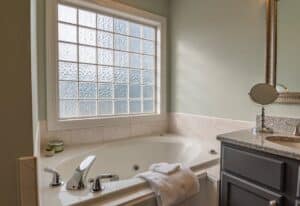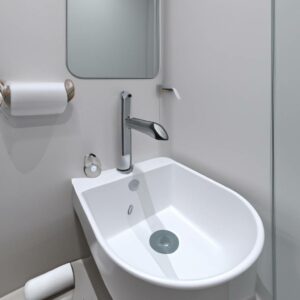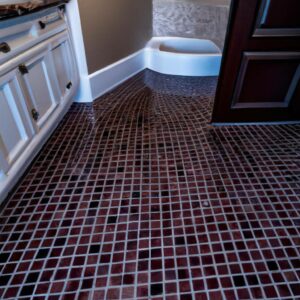A flooded bathroom refers to a situation where an excessive amount of water accumulates in the bathroom, usually due to plumbing issues such as burst pipes, sewer backups, or overflowing toilets. This can lead to significant water damage and potential structural damage if not addressed promptly. Cleaning up a flooded bathroom requires quick action to mitigate the damage, remove excess water, and restore the affected area to its original condition. In this article, we will guide you through the necessary steps and provide helpful tips on how to effectively clean up a flooded bathroom. From identifying the source of the water to drying out the space, we will cover all aspects of the cleanup process to ensure that your bathroom is restored safely and efficiently.
Reasons for a Flooded Bathroom
A flooded bathroom can be a major inconvenience and cause significant damage. There are several reasons why a bathroom may become flooded. One of the most common causes is clogged pipes, which can occur due to the buildup of hair, dirt, and other debris over time. This can prevent water from flowing freely and lead to
Shutting Off the Water Supply
Shutting off the water supply is a crucial step in the process of cleaning up a flooded bathroom to prevent further damage. To do this, you need to locate and turn off the shut-off valves for individual fixtures such as toilets and sinks.
To shut off the water supply to a toilet, look for a valve located on the wall behind or near the toilet base. Turn the valve clockwise until it stops to shut off the water flow. For sinks, the shut-off valves are usually located underneath the sink cabinet. Look for two small valves—one for hot water and one for cold water—and turn them clockwise to close the water supply.
In some cases, shutting off the individual fixture shut-off valves may not stop the water flow. If this happens, you will need to turn off the main water supply to the entire house. Locate the main water shut-off valve, which is typically found near the water meter or where the main water supply enters the house. Turn the valve clockwise until it stops to shut off the water flow to the entire house.
Remember to turn off the water supply if you notice any signs of a bathroom flood to prevent further damage. It is always a good idea to familiarize yourself with the location of shut-off valves in your home to be prepared for any water emergencies
Identifying Electrical Hazards
During a flooded bathroom situation, there can be potential electrical hazards that pose a significant danger to personal safety. The presence of water increases the risk of electrocution, electrical fires, and other accidents. It is crucial to identify and address these hazards safely and promptly.
The first step is to turn off the electricity in the affected area. Locate the circuit breaker panel or fuse box and shut off the power supply to the bathroom. If you are unsure which breaker controls the bathroom, it is best to turn off the main breaker to ensure that no electricity is flowing.
Next, it is essential to identify any electrical hazards that may be present. Look out for any exposed or damaged wiring, electrical outlets, or fixtures that may have been compromised by the flooding. Avoid touching any electrical equipment or wiring with wet hands or while standing in water.
If you notice any electrical hazards, do not attempt to fix them yourself. Contact a licensed electrician to inspect and address the issues. They have the expertise and knowledge to safely handle electrical repairs and ensure that your bathroom is safe.
Remember to always wear appropriate protective gear, such as rubber gloves and non-conductive footwear, when dealing with electrical hazards. These precautions will help minimize the risk of electric shock and other accidents.
In conclusion, it is crucial to promptly address electrical hazards during a flooded bathroom situation to ensure personal safety. Turn off the electricity, identify potential dangers, and contact a licensed electrician for assistance. By taking these necessary steps, you can mitigate the risks and prevent any further harm or accidents.
Wearing Protective Clothing
When it comes to cleaning up a flooded bathroom, wearing the right protective clothing is essential. This not only helps to prevent exposure to contaminated water but also safeguards against potential health hazards.
First and foremost, make sure to have a pair of sturdy rubber gloves. These gloves will protect your hands from coming into direct contact with the water, which may contain harmful bacteria and other contaminants. Additionally, wearing rubber boots is crucial to keep your feet dry and protected from any sharp objects that could be hidden in the water.
To shield your eyes from splashes and potential debris, wearing goggles is a smart move. This will safeguard your eyes from any harmful substances or objects that may be present in the water.
Lastly, consider wearing a face mask to prevent inhalation of any harmful particles or fumes that may be released during the cleanup process. This is particularly important if you are dealing with a sewage backup or other potentially hazardous situations.
Remember, when cleaning up a flooded bathroom, your safety should always be a top priority. By wearing appropriate protective clothing like gloves, rubber boots, goggles, and a face mask, you can minimize the risks associated with exposure to contaminated water and ensure a safer cleanup process.
Staying Away from Contaminated Water Sources
When dealing with a flooded bathroom, it is crucial to prioritize your safety and avoid coming into contact with contaminated water sources. Contaminated water can pose serious health hazards and cause further damage to your home. One of the biggest risks to be aware of is raw sewage. Sewage backups can not only contain harmful bacteria and pathogens, but also toxic fumes. It is vital to avoid touching or getting near raw sewage to prevent the spread of diseases and protect your health.
To ensure the safety of yourself and your family, it is important to dispose of the waste water in a safe location. Avoid draining the water in an area that could harm the environment or your plumbing system. Instead, consider using a sump pump or directing the water to a designated drainage area that won’t cause any harm.
Remember, your health should be the top priority during a bathroom flood. Stay away from contaminated water sources, especially raw sewage, and dispose of waste water in a safe location. By taking these precautions, you can minimize the risks associated with flooded bathroom cleanup.
Cleaning Up the Water
Cleaning up after a water emergency in your bathroom can be a stressful and overwhelming task. Whether it’s due to a burst pipe, a toilet overflow, or a sewage backup, it’s important to address the issue promptly to minimize further damage. With the right tools and techniques, you can successfully clean up the water and restore your bathroom to its previous state. In this guide, we will walk you through the step-by-step process of cleaning up the water in your bathroom, from assessing the extent of the damage to drying out the affected areas and preventing future water emergencies. So, if you’re ready to tackle this challenging task, let’s get started!
Removing Standing Water on Surface Areas and Floors
When faced with a flooded bathroom, it is important to act quickly to remove standing water on surface areas and floors. This not only prevents further damage but also helps maintain a clean and safe environment.
One effective method for removing standing water is by using mops, old towels, and wet/dry vacuum cleaners. Start by using the mop or towels to absorb as much water as possible. Wring out the mop or towels into a bucket or sink, and repeat until the majority of the water has been removed.
For larger amounts of water, a wet/dry vacuum cleaner can be a valuable tool. These vacuums are specifically designed to handle liquid spills and can quickly and efficiently extract water from floors. Be sure to follow the manufacturer’s instructions and use the appropriate attachments for the best results.
It is important to take precautions when dealing with a flooded bathroom. Avoid using ordinary vacuum cleaners, as they are not built to handle water and can become a safety hazard. Additionally, for severe flooding or cases of potential structural damage, consider hiring a professional water damage clean-up service. They have the expertise and equipment to properly assess the situation and handle the clean-up process.
By promptly removing standing water using mops, old towels, and wet/dry vacuum cleaners, you can minimize the damage caused by a flooded bathroom and ensure a quick and effective clean-up process.
Treating Carpets and Upholstery for Water Damage
When dealing with a flooded bathroom, it is crucial to assess and treat any water damage to your carpets and upholstery promptly. Here are the steps to effectively treat carpets and upholstery for water damage:
1. Remove Standing Water: Use mops, towels, or a wet/dry vacuum cleaner to remove as much standing water as possible. Take extra care when dealing with carpets to prevent further damage and saturation.
2. Dry Thoroughly: Open windows, turn on fans, and use dehumidifiers to promote airflow and aid in the drying process. For large amounts of water, consider using commercial-grade fans or renting carpet dryers for faster and more effective drying.
3. Clean and Sanitize: Thoroughly clean and sanitize your carpets and upholstery to prevent mold and bacteria growth. Use a mild detergent and water to gently scrub the affected areas. Alternatively, consult a professional upholstery cleaner or carpet cleaner for specialized treatments.
4. Assess Damage: Inspect your carpets and upholstery for any signs of permanent damage, such as discoloration, odors, or mold growth. If the damage is significant or extends to the padding beneath the carpet, it may be necessary to replace or repair the affected areas.
Different types of flooring, such as tile, laminate, and hardwood, require specific approaches for water damage treatment. For these types of flooring, remove standing water, wipe down the surface, and use fans and dehumidifiers to encourage drying. Consult a flooring specialist or a professional water damage restoration company for specialized guidance.
If the water damage is extensive, or you are unsure of how to treat the damage yourself, it is advisable to seek professional help. Water damage restoration companies have the expertise, equipment, and knowledge to assess the extent of the damage and provide appropriate solutions.
Treating carpets and upholstery for water damage in a flooded bathroom requires prompt action, thorough drying, and proper cleaning procedures. Assess the damage carefully and consider consulting professionals when in doubt to ensure the best possible restoration outcome.
Drying Out the Walls, Ceiling, and Flooring with Fans and Dehumidifiers
After a bathroom flood, it’s crucial to thoroughly dry out the affected areas to prevent further damage and the growth of mold and bacteria. One effective method is to utilize fans and dehumidifiers to promote airflow and reduce excess moisture.
Start by opening windows and doors to allow fresh air to circulate. This helps to ventilate the space and expedite the drying process. Additionally, open cabinets and drawers to ensure proper airflow and to prevent the buildup of moisture.
Next, strategically position fans throughout the affected area, aiming them towards the walls, ceiling, and flooring. The airflow generated by fans helps to evaporate the moisture and speed up the drying time. For more substantial water damage, consider renting commercial-grade fans or air movers, which are designed to move larger volumes of air and dry surfaces faster.
In conjunction with fans, employ dehumidifiers to remove excess moisture from the air. Dehumidifiers are particularly useful for pulling moisture out of porous materials like drywall and wood. Place them in the flood-affected area, ensuring that they are set to the appropriate humidity level for optimal drying.
During the drying process, it is essential to check for any signs of seepage, softness, or potential mold growth on the walls, ceiling, and flooring. If any of these issues are present, it may be necessary to remove and replace the water-soaked materials to prevent further damage and ensure a safe and healthy environment.
For more significant water damage or if you are uncertain about handling the drying process yourself, it is advisable to hire a professional water damage restoration company. They have the expertise, equipment, and knowledge to assess the extent of the damage and provide specialized solutions. In certain cases, they may employ additional equipment such as HEPA air scrubbers to effectively remove mold particles from the air, ensuring a thorough and safe drying process.
By following these steps and utilizing fans, dehumidifiers, and professional assistance if needed, you can effectively dry out the walls, ceiling, and flooring after a bathroom flood, mitigating further damage and promoting a healthy environment.
Safety Precautions
Before beginning the clean-up process after a bathroom flood, it is important to prioritize safety to prevent any potential injuries or accidents. Here are some essential safety precautions to consider:
1. Ensure the water supply is turned off: The first step is to locate and turn off the isolation valve or the main water shutoff valve to stop the flow of water into the bathroom. This will help prevent further flooding and minimize water damage.
2. Switch off the electricity: Make sure to turn off the circuit breaker panel or disconnect the power supply to the affected area. Water and electricity can be a dangerous combination, so it is crucial to keep yourself and others safe by cutting off the electrical source.
3. Use personal protective equipment (PPE): Wear waterproof gloves, rubber boots, and safety goggles to protect yourself from any potential hazards while cleaning up the floodwater. This is especially important if the water may be contaminated with sewage or other harmful substances.
4. Beware of slippery surfaces: Take extra caution while walking on wet floors to avoid slips and falls. Place bath mats or towels on the floor to absorb excess moisture and provide traction.
5. Avoid contact with sewage backups: If the floodwater contains sewage or other contaminants, avoid direct contact with it. Sewage backups can pose serious health risks, so it is advisable to call a professional water damage restoration company to handle the cleanup.
By following these safety precautions, you can minimize the risk of accidents and ensure a safe and effective clean-up process. Remember, it is always better to seek professional help if the flooding is extensive or if you are unsure about handling the situation yourself.
Conclusion
Having a flooded bathroom can be a nightmare. However, with the right supplies and knowledge, it doesn’t have to be. The first step is to shut off the water supply and plug any drains to prevent further flooding. Then start mopping up the water and dispose of any items that have been damaged. Finally, use a combination of fans and dehumidifiers to dry up the area.
With this guide, you now have the basic steps and knowledge needed to clean up a flooded bathroom. Taking quick action and having the right supplies can help minimize the damage and save you time and money in the long run. So don’t wait – if you find yourself in this situation, start cleaning up your flooded bathroom today!





